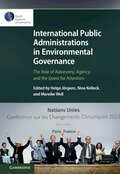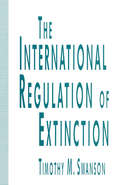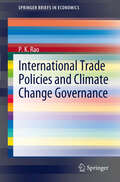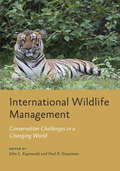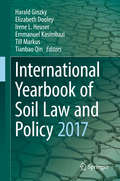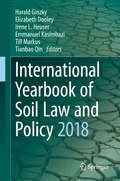- Table View
- List View
International Public Administrations in Environmental Governance: The Role of Autonomy, Agency, and the Quest for Attention
by Helge Jörgens Nina Kolleck Mareike WellCombining theoretical and empirical approaches, this book examines the role that international public administrations play in global environmental politics in the Anthropocene. With chapters written by leading experts in the field, this text offers fresh insight into how international bureaucracies shape global policies in the complex areas of climate change, biodiversity, and development policy. International public administrations are thus recognized as partially autonomous actors with their own interests and motivations, assuming the roles of managers, orchestrators, brokers, or attention-seekers. This comprehensive resource provides scholars and practitioners with valuable insight into environmental policymaking and how international public administrations might be transformed to better address the multiple, fundamental challenges of our century. This is one of a series of publications associated with the Earth System Governance Project. For more publications, see www.cambridge.org/earth-system-governance. This title is also available as Open Access on Cambridge Core.
The International Regulation of Extinction
by Timothy M. SwansonSwanson's book provides a good framework for understanding the extinction process in deeper socio-economic terms, and for evaluating some of the suggestions that have been made to arrest the decline. I am sure it will be of great interest to environmental economists working in this area.' - A. Markandya, Harvard Institute for International Development 'Tim Swanson's International Regulation of Extinction is the most important work on biodiversity to appear for many years. It should cause all concerned, environmentalists, economists, governments, regulators, international agencies to think again. They have misunderstood the causes of extinction, and have misdirected many of their policies as a result. Tim Swanson's work will spawn a whole new era of research. Most importantly, it can help save the world's biodiversity.' - Professor David Pearce, Director, CSERGE, University College London The book presents an economic analysis of the forces contributing to the global decline of biological diversity, and the policies available to control extinctions. The first part of the volume sets forth a revised economic theory of extinction, incorporating the terrestrial and institutional constraints on maintaining existing diversity. It analyses the existing conflicts between human development and biological diversity, entailing an application of the economic theory of learning-by-doing and global nonconvexities. The second half of the volume demonstrates the inefficiency of decentralised (multinational) regulation of biological diversity, and develops the range of approaches available in a global (international) approach to the resource. The policies analysed include transferable development rights, wildlife trade regimes, and intellectual property rights. The book concludes with a proposed agenda for the specification of the framework convention on biological diversity adopted at UNCED in Rio de Janeiro.
International Relations in the Anthropocene: New Agendas, New Agencies and New Approaches
by David Chandler Delf Rothe Franziska MüllerThis textbook introduces advanced students of International Relations (and beyond) to the ways in which the advent of, and reflections on, the Anthropocene impact on the study of global politics and the disciplinary foundations of IR. The book contains 24 chapters, authored by senior academics as well as early career scholars, and is divided into four parts, detailing, respectively, why the Anthropocene is of importance to IR, challenges to traditional approaches to security, the question of governance and agency in the Anthropocene, and new methods and approaches, going beyond the human/nature divide.
International Relations in the Arctic: Norway and the Struggle for Power in the New North
by Leif Christian JensenAs the ice around the Arctic landmass recedes progressively further each year, the territory has become a flashpoint in world affairs. New and lucrative trade routes from East to West are now becoming accessible for shipping lanes and military deployment, and the Arctic is known to be home to large gas and oil reserves. Yet the territorial boundaries of the region remain ill-defined. In response to these geographical changes the Scandinavian countries, especially Denmark and Norway, have begun staking large proprietary claims in the face of pressure from the major powers - Russia, Canada, the US and China - for the trade routes to be designated as International Waters. Here, Norwegian scholar Leif Christian Jensen shows how Norway has undergone a positional shift after declaring its assertive position on the Arctic in 2005. Its disputes with Russia have created a new foreign policy dilemma, and a new set of 'red-lines' in Norwegian policy. Is Norway, as it would like to be seen, an environmentally friendly, peaceful, 'enlightened' nation? Or does this geopolitical shift in world affairs necessitate a new and more aggressive Scandinavia?International Relations in the Arctic makes a timely contribution to the 'turn to the North' in International Relations and Political Science.
International Relations in the Post-Industrial Era: Rephrasing the Third World
by A. NatellaThe current emphasis on the greening of the world marks a beginning of a new concern for our relationship with our planet. This book states that we are entering into a new era - a transitional time in history in which the values of the industrial revolution are being replaced by a post-industrial consciousness.
International Science and Technology Education: Exploring Culture, Economy and Social Perceptions (The Earthscan Science in Society Series)
by Ortwin Renn Nicole C. Karafyllis Andreas Hohlt Dorothea TaubeEducation in science, technology, engineering and mathematics (STEM) is crucial for taking advantage of the prospects of new scientific discoveries initiating or promoting technological changes, and managing opportunities and risks associated with innovations. This book explores the emerging perspectives and methodologies of STEM education and its relationship to the cultural understanding of science and technology in an international context. The authors provide a unique perspective on the subject, presenting materials and experiences from non-European industrialized as well as industrializing countries, including China, Japan, South Korea, India, Egypt, Brazil and the USA. The chapters offer a wide scope of interpretations and comparative reviews of STEM education by including narrative elements about cultural developments, considering the influence of culture and social perceptions on technological and social change, and applying innovative tools of qualitative social research. The book represents a comprehensive and multidisciplinary review of the current status and future challenges facing STEM education across the world, including issues such as globalization, interdependencies of norms and values, effects on equity and social justice as well as resilience. Overall the volume provides valuable insights for a broad and comprehensive international comparison of STEM philosophies, approaches and experiences.
International Science and Technology Education: Exploring Culture, Economy and Social Perceptions (The Earthscan Science in Society Series)
by Ortwin Renn Nicole C. Karafyllis Andreas Hohlt Dorothea TaubeEducation in science, technology, engineering and mathematics (STEM) is crucial for taking advantage of the prospects of new scientific discoveries initiating or promoting technological changes, and managing opportunities and risks associated with innovations. This book explores the emerging perspectives and methodologies of STEM education and its relationship to the cultural understanding of science and technology in an international context. The authors provide a unique perspective on the subject, presenting materials and experiences from non-European industrialized as well as industrializing countries, including China, Japan, South Korea, India, Egypt, Brazil and the USA. The chapters offer a wide scope of interpretations and comparative reviews of STEM education by including narrative elements about cultural developments, considering the influence of culture and social perceptions on technological and social change, and applying innovative tools of qualitative social research. The book represents a comprehensive and multidisciplinary review of the current status and future challenges facing STEM education across the world, including issues such as globalization, interdependencies of norms and values, effects on equity and social justice as well as resilience. Overall the volume provides valuable insights for a broad and comprehensive international comparison of STEM philosophies, approaches and experiences.
International Students in American Colleges and Universities: A History
by T. BevisA fascinating and important history of foreign students in American higher education. The book will have appeal to specialists in student services, but also to the thousands of faculty members responsible for teaching and mentoring foreign students.
International Support for Domestic Climate Policies in Developing Countries
by Karstan NeuhoffThis volume examines how international cooperation can support implementation of domestic climate policies in developing countries. Six case studies explore the domestic drivers and barriers for policies with climate (co-)benefits in developing countries and show that international support can help to overcome these constraints by providing additional resources for incremental policy costs, technical assistance, and technology cooperation to build local capacity. Cooperation can also contribute to robust institutional frameworks and government policies that facilitate increased private sector investment, which supports low-carbon production and consumption. Any such cooperation has to be anchored in domestic initiatives - building on stakeholder support for policies with climate co-benefits. The studies also examines the important role played by policy indicators in successful policy implementation and how they can be linked to international incentive schemes. The contributions in this volume examine cases from institutional and national perspectives from across the globe and find that, with common but differentiated responsibility for climate policy, developed countries have to contribute more towards technological and financial support in developing countries.
International Support for Domestic Climate Policies in Developing Countries
by Karstan NeuhoffThis volume examines how international cooperation can support implementation of domestic climate policies in developing countries. Six case studies explore the domestic drivers and barriers for policies with climate (co-)benefits in developing countries and show that international support can help to overcome these constraints by providing additional resources for incremental policy costs, technical assistance, and technology cooperation to build local capacity. Cooperation can also contribute to robust institutional frameworks and government policies that facilitate increased private sector investment, which supports low-carbon production and consumption. Any such cooperation has to be anchored in domestic initiatives - building on stakeholder support for policies with climate co-benefits. The studies also examines the important role played by policy indicators in successful policy implementation and how they can be linked to international incentive schemes. The contributions in this volume examine cases from institutional and national perspectives from across the globe and find that, with common but differentiated responsibility for climate policy, developed countries have to contribute more towards technological and financial support in developing countries.
International Trade and Climate Change Policies
by Duncan BrackFocusing on the likely impacts on trade of the UN Framework Convention on Climate Change and the Kyoto Protocol, this book examines the actual and potential conflicts between whether liberalization of trade undermines the efforts of industrialised countries to mitigate climate change. It will be essential reading for environmental economists and those engaged in international environmental relations and policy.
International Trade and Climate Change Policies
by Duncan Brack Michael Grubb Craig WindramFocusing on the likely impacts on trade of the UN Framework Convention on Climate Change and the Kyoto Protocol, this book examines the actual and potential conflicts between whether liberalization of trade undermines the efforts of industrialised countries to mitigate climate change. It will be essential reading for environmental economists and those engaged in international environmental relations and policy.
International Trade in Forest Products: Lumber Trade Disputes, Models and Examples
by Joseph Buongiorno Jinggang Guo Craig Johnston Xintong Li Fatemeh Mokhtarzadeh Harry Nelson Prakash Nepal Jeffrey Prestemon Brad StennesBecause of the long-standing Canada-U.S. lumber trade dispute and the current pressure on the world's forests as a renewable energy source, much attention has been directed toward the modelling of international trade in wood products. Two types of trade models are described in this book: one is rooted in economic theory and mathematical programming, and the other consists of two econometric/statistical models--a gravity model rooted in theory and an approach known as GVAR that relies on time series analyses. The purpose of the book is to provide the background theory behind models and facilitate readers in easily constructing their own models to analyse policy questions that they wish to address, whether in forestry or some other sector. Examples in the book are meant to illustrate how models can be used to say something about a variety of issues, including identification of the gains and losses to various players in the North American softwood lumber business, and the potential for redirecting sales of lumber to countries outside the United States. The discussion is expanded to include other products besides lumber, and used to examine, for example, the effects of log export restrictions by one nation on all other forestry jurisdictions, the impacts of climate policies as they relate to the global forest sector, and the impact of oil prices on forest product markets throughout the world. This book will appeal to practising economists and researchers who wish to examine various policies that affect international trade, whether their interest is local or international in scope. Because the book provides the theoretical bases underlying various models, students and practitioners will find this a valuable reference book or supplementary textbook.
International Trade in Wildlife (Routledge Library Editions: Conservation #2)
by Tim Inskipp Sue WellsOriginally published in 1979 International Trade in Wildlife is a product of the 1973 Convention on International Trade in Endangered Species of Wild Fauna and Flora conference, containing the full text of the CITIES convention. The volume outlines the animals and plants controlled by CITIES, and describes the protective policies put in place to protect endangered plants and animals. It gives a detailed background to the international traffic in monkey’s, spotted cats, whales, ivory, parrots, tortoises, marine turtles, crocodiles, butterflies, sponges and rare orchids at the time of publication and acts as a comprehensive document on the conservation policies enacted through CITIES, as well as facts surrounding the decline of endangered species. Although published over 40 years ago, the document still offers a comprehensive and useful guide to conservation and will be an important historical document for environmental policy makers and conservationists alike.
International Trade in Wildlife (Routledge Library Editions: Conservation #2)
by Tim Inskipp Sue WellsOriginally published in 1979 International Trade in Wildlife is a product of the 1973 Convention on International Trade in Endangered Species of Wild Fauna and Flora conference, containing the full text of the CITIES convention. The volume outlines the animals and plants controlled by CITIES, and describes the protective policies put in place to protect endangered plants and animals. It gives a detailed background to the international traffic in monkey’s, spotted cats, whales, ivory, parrots, tortoises, marine turtles, crocodiles, butterflies, sponges and rare orchids at the time of publication and acts as a comprehensive document on the conservation policies enacted through CITIES, as well as facts surrounding the decline of endangered species. Although published over 40 years ago, the document still offers a comprehensive and useful guide to conservation and will be an important historical document for environmental policy makers and conservationists alike.
International Trade Policies and Climate Change Governance (SpringerBriefs in Economics)
by P.K. RaoThis work offers a synthesis of the current approaches toward an integration of international trade and climate change, with a view to fostering potential improvements in policies and institutions affecting these. A number of pragmatic measures are proposed with reference to the WTO and the United Nations Framework Convention on Climate Change (UNFCCC) regimes, which are expected to contribute toward enhanced climate change governance, as well as promoting international trade.
International Water Law and the Quest for Common Security (Earthscan Studies in Water Resource Management)
by Bjorn-Oliver MagsigThe world’s freshwater supplies are increasingly threatened by rapidly increasing demand and the impacts of global climate change, but current approaches to transboundary water management are unsustainable and may threaten future global stability and international security. The absence of law in attempts to address this issue highlights the necessity for further understanding from the legal perspective. This book provides a fresh conceptualisation of water security, developing an operational methodology for identifying the four core elements of water security which must be addressed by international law: availability; access; adaptability; and ambit. The analysis of the legal framework of transboundary freshwater management based on this contemporary understanding of water security reveals the challenges and shortcomings of the current legal regime. In order to address these shortcomings, the present mindset of prevailing rigidity and state-centrism is challenged by examining how international legal instruments could be crafted to advance a more flexible and common approach towards transboundary water interaction. The concept of considering water security as a matter of ‘regional common concern’ is introduced to help international law play a more prominent role in addressing the challenges of global water insecurity. Ways for implementing such an approach are proposed and analysed by looking at international hydropolitics in Himalayan Asia. The book analyses transboundary water interaction as a ‘case study’ for advancing public international law in order to fulfil its responsibility of promoting international peace and security.
International Water Law and the Quest for Common Security (Earthscan Studies in Water Resource Management)
by Bjorn-Oliver MagsigThe world’s freshwater supplies are increasingly threatened by rapidly increasing demand and the impacts of global climate change, but current approaches to transboundary water management are unsustainable and may threaten future global stability and international security. The absence of law in attempts to address this issue highlights the necessity for further understanding from the legal perspective. This book provides a fresh conceptualisation of water security, developing an operational methodology for identifying the four core elements of water security which must be addressed by international law: availability; access; adaptability; and ambit. The analysis of the legal framework of transboundary freshwater management based on this contemporary understanding of water security reveals the challenges and shortcomings of the current legal regime. In order to address these shortcomings, the present mindset of prevailing rigidity and state-centrism is challenged by examining how international legal instruments could be crafted to advance a more flexible and common approach towards transboundary water interaction. The concept of considering water security as a matter of ‘regional common concern’ is introduced to help international law play a more prominent role in addressing the challenges of global water insecurity. Ways for implementing such an approach are proposed and analysed by looking at international hydropolitics in Himalayan Asia. The book analyses transboundary water interaction as a ‘case study’ for advancing public international law in order to fulfil its responsibility of promoting international peace and security.
International Wildlife Management: Conservation Challenges in a Changing World (Wildlife Management and Conservation)
by John L. Koprowski Paul R. KrausmanHabitat loss, disease management, predator-human conflict, illegal trade—these are among the many conservation challenges faced by wildlife experts around the world. But how wildlife professionals approach these issues has historically been geographically fragmented. By providing a broad perspective on issues faced by wildlife on an international scale, the authors of International Wildlife Management make vital connections, drawing attention to underlying causes and strategies for mitigation that may look surprisingly similar from Montana to Zimbabwe. Bringing together wildlife professionals from around the globe to discuss shared challenges, International Wildlife Management• examines widespread patterns of wildlife loss• covers key conservation strategies, including species reintroduction, community engagement, and wildlife commerce• explores the urgent concerns of climate change, habitat loss and fragmentation, invasive species, and poaching• reviews major organizations involved in wildlife management at an international level, highlighting examples of cooperation among groups and nations in effective wildlife management efforts• features stories of success and struggle from authors across 17 countries on 6 continents This timely and thorough overview thinks big by assessing threats to wildlife on a global scale. Wild creatures don't recognize artificial geographic borders. This useful compendium demonstrates that researchers and scientists should follow their lead.
International Wildlife Management: Conservation Challenges in a Changing World (Wildlife Management and Conservation)
by John L. Koprowski Paul R. KrausmanHabitat loss, disease management, predator-human conflict, illegal trade—these are among the many conservation challenges faced by wildlife experts around the world. But how wildlife professionals approach these issues has historically been geographically fragmented. By providing a broad perspective on issues faced by wildlife on an international scale, the authors of International Wildlife Management make vital connections, drawing attention to underlying causes and strategies for mitigation that may look surprisingly similar from Montana to Zimbabwe. Bringing together wildlife professionals from around the globe to discuss shared challenges, International Wildlife Management• examines widespread patterns of wildlife loss• covers key conservation strategies, including species reintroduction, community engagement, and wildlife commerce• explores the urgent concerns of climate change, habitat loss and fragmentation, invasive species, and poaching• reviews major organizations involved in wildlife management at an international level, highlighting examples of cooperation among groups and nations in effective wildlife management efforts• features stories of success and struggle from authors across 17 countries on 6 continents This timely and thorough overview thinks big by assessing threats to wildlife on a global scale. Wild creatures don't recognize artificial geographic borders. This useful compendium demonstrates that researchers and scientists should follow their lead.
International Yearbook of Soil Law and Policy 2016 (International Yearbook of Soil Law and Policy #2016)
by Harald Ginzky Irene L. Heuser Tianbao Qin Oliver C. Ruppel Patrick WegerdtThe first volume of the International Yearbook of Soil Law and Policy includes an important discussion on the implementation of the Sustainable Development Goals that are the basis for the post-2015 development agenda up to the year 2030; the Yearbook focuses in particular on Goal 15, which includes achieving a “land degradation-neutral world.” It also provides a comprehensive and highly informative overview of the latest developments at the international level, important cross-disciplinary issues and different approaches in national legislation. The book is divided into four sections. Forewords by internationally renowned academics and politicians are followed by an analysis of the content and structure of the Sustainable Development Goals with regard to soil and land as well as the scientific methods for their implementation. In addition, all relevant international regimes are discussed, including the latest developments, such as the decisions made at the 12th Conference of the Parties to the United Nations Convention to Combat Desertification (UNCCD) and the Paris Agreement on Climate Change. The next section deals with cross-disciplinary issues relevant to the implementation of the Sustainable Development Goals like the right to food, land tenure, migration and the “Economics of Land Degradation” initiative. The last section gathers reports on the development of national legislation from various nations and supra-national entities, including Brazil, China, the European Union, Mongolia, Namibia and the United States. Addressing this broad range of key topics, the book offers an indispensible tool for all academics, legislators and policymakers working in this field. The “International Yearbook of Soil Law and Policy” is a book series that discusses the central questions of law and politics with regard to the protection and sustainable management of soil and land – at the international, national and regional level.
International Yearbook of Soil Law and Policy 2017 (International Yearbook of Soil Law and Policy #2017)
by Harald Ginzky Elizabeth Dooley Irene L. Heuser Emmanuel Kasimbazi Till Markus Tianbao QinThis book presents an important discussion on soil and sustainable agriculture from a range of perspectives, addressing key topics such as sustainable intensification, the FAO Voluntary Guidelines, and the crucial role of appropriate tenure rights. This second volume of the International Yearbook of Soil Law and Policy is divided into four parts, the first of which deals with several aspects of the theme “soil and sustainable agriculture.” In turn, the second part covers recent international developments, the third part presents regional and national reports, and the fourth discusses cross-cutting issues. Given the range of key topics covered, the book offers an indispensable tool for all academics, legislators and policymakers working in this field. The “International Yearbook of Soil Law and Policy” is a book series that discusses central questions in law and politics with regard to the protection and sustainable management of soil and land – at the international, national and regional level. The Chapter "The Use of Property Law Tools for Soil Protection" by Jessica Owley is available open access under a CC BY 4.0 license at link.springer.com.
International Yearbook of Soil Law and Policy 2018 (International Yearbook of Soil Law and Policy #2018)
by Harald Ginzky Elizabeth Dooley Irene L. Heuser Emmanuel Kasimbazi Till Markus Tianbao QinThis book presents an important discussion on urbanization and sustainable soil management from a range of perspectives, addressing key topics such as sustainable cities, soil sealing, rehabilitation of contaminated soils, property rights and liability issues, as well as trading systems with regard to land take.This third volume of the International Yearbook of Soil Law and Policy is divided into four parts, the first of which explores several aspects of the topic “urbanization and sustainable management of soils.” The second part then covers recent international developments, while the third part presents regional and national reports, and the fourth discusses cross-cutting issues. Given the range of key topics covered, the book offers an indispensible tool for all academics, legislators and policymakers working in this field. The “International Yearbook of Soil Law and Policy” series discusses central questions in law and politics with regard to the protection and sustainable management of soil and land – at the international, national and regional level.
International Yearbook of Soil Law and Policy 2019 (International Yearbook of Soil Law and Policy #2019)
by Harald Ginzky Elizabeth Dooley Irene L. Heuser Emmanuel Kasimbazi Robert Kibugi Till Markus Tianbao Qin Oliver RuppelThis book presents an important discussion on the implementation of sustainable soil management in Africa from a range of governance perspectives. It addresses aspects such as the general challenges in Africa with regard to soil management; the structural deficiencies in legal, organizational and institutional terms; and specific policies at the national level, including land cover policies and persistent organic pollutants.This fourth volume of the International Yearbook of Soil Law and Policy is divided into four parts, the first of which deals with several aspects of the theme “sustainable soil management in Africa.” In turn, the second part covers recent international developments, the third part presents regional and national reports (i.a. Mexico, USA and Germany), and the fourth discusses cross-cutting issues(i.a. on rural-urban interfaces). Given the range of key topics covered, the book offers an indispensible tool for all academics, legislators and policymakers working in this field.The “International Yearbook of Soil Law and Policy” is a book series that discusses central questions in law and politics with regard to the protection and sustainable management of soil and land – at the international, national and regional level.
International Yearbook of Soil Law and Policy 2020/2021 (International Yearbook of Soil Law and Policy #2020)
by Harald Ginzky Elizabeth Dooley Irene L. Heuser Patricia Kameri-Mbote Robert Kibugi Till Markus Oliver C. RuppelThis book presents an important discussion on land tenure rights for the effective implementation of sustainable soil management provisions. It investigates a variety of aspects, such as the clash of modern and traditional tenure concepts, forms of illegal or illegitimate land acquisition, and the preconditions for legal and legitimate investments. In addition, the book analyses the challenges to ensuring secure land tenure rights in Africa and in Germany. Lastly, it provides information on the role of women in this context.This fifth volume of the International Yearbook of Soil Law and Policy is divided into four parts, the first of which deals with various aspects of the theme “Land Tenure Rights and Sustainable Soil Management”. The second part covers recent international developments, the third part presents regional and national reports, and the fourth discusses overarching issues. Given the range of key topics covered, the book offers an indispensable tool for all academics, legislators and policymakers working in this field.The “International Yearbook of Soil Law and Policy” series discusses central questions in law and politics with regard to the protection and sustainable management of soil and land – at the international, national, and regional level.
